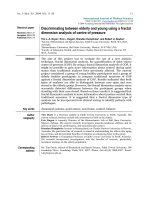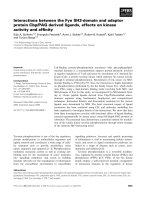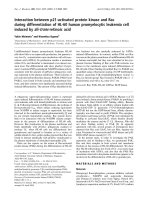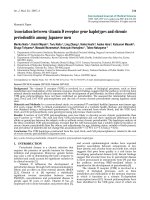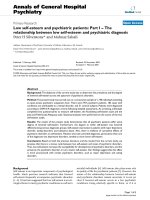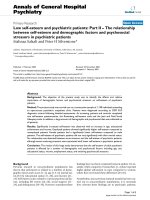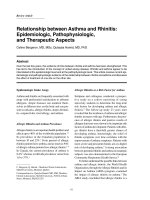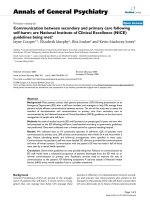Báo cáo y học: "Difference between pre-operative and cardiopulmonary bypass mean arterial pressure is independently associated with early cardiac surgery-associated acute kidney injury" pps
Bạn đang xem bản rút gọn của tài liệu. Xem và tải ngay bản đầy đủ của tài liệu tại đây (584.5 KB, 9 trang )
RESEARC H ARTIC LE Open Access
Difference between pre-operative and
cardiopulmonary bypass mean arterial pressure is
independently associated with early cardiac
surgery-associated acute kidney injury
Hussein D Kanji
1
, Costas J Schulze
1,2
, Marilou Hervas-Malo
3
, Peter Wang
1
, David B Ross
1,2
, Mohamad Zibdawi
1,2,4
,
Sean M Bagshaw
2,3,4*
Abstract
Background: Cardiac surgery-associated acute kidney injury (CSA-AKI) contributes to increased morbidity and
mortality. However, its pathophysi ology remains incompletely understood. We hypothesized that intra-operative
mean arterial pressure (MAP) relative to pre-ope rative MAP would be an important predisposing factor for CSA-AKI.
Methods: We performed a prospective observational study of 157 consecutive high-risk patients undergoing
cardiac surgery with cardiopulmonary bypass (CPB). The primary exposure was delta MAP, defined as the pre-
operative MAP minus average MAP during CPB. Secondary exposure was CPB flow. The primary outcome was early
CSA-AKI, defined by a minimum RIFLE class - RISK. Univariate and multivariate logistic regression were performed
to explore for association between delta MAP and CSA-AKI.
Results: Mean (± SD) age was 65.9 ± 14.7 years, 70.1% were male, 47.8% had isolated coronary bypass graf t
(CABG) surgery, 24.2% had isolated valve surgery and 16.6% had combined procedures. Mean (± SD) pre-operative,
intra-operative and delta MAP were 86.6 ± 13.2, 57.4 ± 5.0 and 29.4 ± 13.5 mmHg, respectively. Sixty-five patients
(41%) developed CSA-AKI within in the first 24 hours post surgery. By multivariate logistic regression, a delta
MAP≥26 mmHg (odds ratio [OR], 2.8; 95%CI, 1.3-6.1, p = 0.009) and CPB flow rate ≥54 mL/kg/min (OR, 0.2, 0.1-0.5,
p < 0.001) were independently associate d with CSA-AKI. Additional variables associated with CSA-AKI included use
of a side-biting aortic clamp (OR, 3.0; 1.3-7.1, p = 0.012), and body mass index ≥25 (OR, 4.2; 1.6-11.2, p = 0.004).
Conclusion: A large delta MAP and lower CPB flow during cardiac surgery are independently associated with early
post-operative CSA-AKI in high-risk patients. Delta MAP represents a potentially modifiable intra-operative factor for
development of CSA-AKI that necessitates further inquiry.
Introduction
Acute kidney injury (AKI) following cardiac surgery with
cardiopulmonary bypass (CPB) can be a devastating
complication associated with high morbidity, mortality
and resource utilization [1,2]. The incidence of cardiac
surgery-associated AKI (CSA-AKI) has ranged between
5-30% [3,4]. This variability is largely attributable to the
numerous definitions applied in prior studies and
assessment of inconsistent at-risk patient populations.
Severe AKI prompting initiation of renal replacement
therapy (RRT) after cardiac surgery is uncommon, how-
ever, has been associated with a 7.9 fold increased risk
of de ath [5]. However, even r elatively m ild rises in
serum creatinine in the immediate post-operative period
have been associated with reduced survival [6].
Despite the deleterious i mpact of C SA-AKI on ou t-
come, its pathophysiology remains incompletely under-
stood. The extracorporeal circuit and CPB have been
implicated as key contributing factors [7,8]. In parti-
cular, pre-existing chronic kidney disease (CKD),
* Correspondence:
2
Mazankowski Alberta Heart Institute, University of Alberta, Edmonton,
Canada
Full list of author information is available at the end of the article
Kanji et al. Journal of Cardiothoracic Surgery 2010, 5:71
/>© 2010 Kanji et al; licensee BioMed Centra l Ltd. This is an Open Access article distributed under the terms of the Creative Commons
Attribution License ( ), which permits unrestrict ed use, distribution, and reproduction in
any medium, provided the original work is properly cited.
prolonged aortic cross clamp and CBP duration have
been found to predict CSA-AKI [9,10]. In general, how-
ever, t here is a paucity of data that has focused on the
association between specific intra-operative CPB para-
meters and risk of CSA-AKI [11].
Accordingly, we performed a prospective observational
study of patients undergoing cardiac surgery with CPB
at high-risk for CSA-AKI. Our objective was to evaluate
for associations between intra-operative CPB parameters
and early post-operative CSA-AKI. Specifically, we
examined the effect of: 1) delta mean arterial pressure
(MAP); and 2) CPB flow on the risk for early post-
operative CSA-AKI.
Methods
Study Design
This was a prospective observational cohort study. Con-
secutive patients undergoing c ardiac surgery with CPB
at the Mazankowski Alberta Hea rt Institute, Univ ersity
of Alberta Hospital in Edmonton, Canada between July
1, 2008 and October 31, 2008 were screened for enroll-
ment. The cardiac surgery program has eight surgeons
who perf orm approximatel y 140 0 open heart cases with
CPB per year. The Health Research Ethics Board at the
University of Alberta approved t he protocol prior to
commencement.
Study Population
Patients with features putting them at risk for CSA-AKI
were recruited for this study. For this study, pat ients
deemed “ high-risk” wereadoptedfromThakaretal
[12-14]andincludedpatientswhohadatleastoneof
the following: age ≥70 years; insu lin-dependent diabetes
mellitus (DM); congestive heart failure or documented
LVEF <35%; New York Heart Association (NYHA)
symptom severity class 3 or 4; pre-operative serum crea-
tinine ≥106 μmol/L; valve surgery only; valve surgery +
CABG or complex surger y; and/or previous cardiac sur-
gery. Inclusion criteria were adult patients (age ≥18
years) undergoing cardiac s urgery with CPB and pre-
sence of at least 1 high-risk criterion. Exclusion criteria
included: planned off-pump cardiac surgery; cardiac or
lung transplantation; isolated ventricular device inser-
tion; and end-stage kidney disease (CKD class V) or
prior kidney transplantation.(Figure 1)
Study Definitions
Acute kidney injury (AKI) was defined using the RIFLE
classification scheme where the three strata of injury
were defined as: i) RISK - serum creatinine increase ×1.5
baseline or urine output <0.5 ml/kg/hour × 6 hours, ii)
INJURY - serum creatinine increase ×2.0 or urine output
<0.5 ml/kg/hour × 12 hours, and iii) FAILURE - serum
creatinine ×3.0 or urine output <0.3 ml/kg/hour × 24
hours or anuria for 12 hours [15]. We ascertained for
AKI within the first 24 post-operative hours after cardiac
surgery. The rationale for this “early” definition was to
capture AKI most likely attributable to intra-operative
factors such as C PB, rather than factors in the post-
operative period. Delta MAP was defined as baseline
MAP (acquired from three independent pre-operative
blood pressure readings) minus the average MAP on
CPB (calculated as t he average of MAP readings at
15 minute intervals during CPB).
Study Protocol
For those patients enrolled, detailed data collection was
performed. All data were extracted using standardized
case-report forms and entered into a central Acc ess
2003 dat abase (Microsoft Corp, Richmond, USA). Data
extracted included: demographics (e.g. age, sex, pre-
morbid illness, pre-operative medications), pre-operative
kidney function, s urgical details (e.g. coronary bypass,
value replacement, technique, cross-clamp time), intra-
operative parameters (e.g. mean perfusion pressure,
flow, concomitant ultrafiltration, temperature, hemato-
crit, transfusions, use of vasoactive medication, use of
anti-fibrinolytics) and post-operative details (e.g. clinical,
physiologic and laboratory data). Data were also ascer-
tained on clinical outcomes including: occurrence of
AKI, receipt of RRT, duration of mechanical ventilation,
lengths of stay and hospital mortality. Postoperative data
was collected for 5 days. Pre-operative MAP was calcu-
lated as an average of three distinct measurements of
blood pressure separated by greater than 24 hours
between readings. Two of the measurements w ere con-
ducted preoperatively using an automated blood-pres-
sure cuff (pre-admission clinic and on admission to the
hospital), the third was extracted from anesthesiol ogist’ s
record prior to administration of anesthesia from the
radial arterial line.
Operation and CPB
All surgeries were performed through a midline sternot-
omywiththeuseofCPB.CPBwasinstitutedusing
standard techniques with cannulation of the right atrium
with a 4 2F cavoatrial venous cannula and the ascending
aorta with a 20 or 22F aortic cannula. In the case of
mitral valve surgery a bicaval cannulation technique
with a 30F SVC- and 34F IVC-cannula was employed
for venous drainage. A phosphorylcholin coated mem-
brane oxygenator (Dideco 903 Avant™) and roller pump
(Stöckert S-3 or S-5, Stöckert Instrument GmbH,
Munich, Germany) was used in all patients. The phos-
phorylc holin coated (PHISIO™, Dideco, Mirandola, Italy)
circuit was primed with Plasma-Lyte® 500 ml, Penta-
span® 500 ml, Mannitol 25 g and 10000 units of unfrac-
tionated heparin (UH). Permissive hypothermia was
Kanji et al. Journal of Cardiothoracic Surgery 2010, 5:71
/>Page 2 of 9
allowed, temperature was measured with a rectal probe
and maintained at >33°C.
UH (400 units/kg) was given prior to cannulation.
Activated clotting time was maintained at ≥480 seconds
during the procedure. Nonpulsatile pump flow rates
were kept at 2.4 L/min/m
2
and the MAP was adjusted
to keep the surgical field bloodless and to avoid severe
hypotension <50 mmHg. In general the targeted MAP
was 60 mmHg. To maintain the filling volume of the
extracorporeal circuit, colloids (Pentaspan®) and Ringer’s
Lactate solution were added. When the hemoglobin was
less than 70 g/L, packed red blood cells were transfused.
Blood cardioplegia with modified Buckberg solution at a
ratio of 4:1 with high potassiu m (20 mmol/L) at induc-
tion, and at a ratio of 16:1 with low potassium (8 mmol/
L) for maintenance was used for myocardial protection.
Cardioplegic solution was delivered in an antegrade
fashion via the aortic root or by direct cannulation of
thecoronaryostiaorinaretrogradefashionviathe
coronary sinus. Heparin was reversed with protamine
following decannulation.
Patients were transferred to the cardiovascular surgical
intensive care unit post-op era tively. All fluid, inotropes,
hemodynamics and lab values including creatinine were
recorded for 5 days post-operatively. Post-operative
patient management included radial a rterial pressure
monitoring and in some cases thermodilution pulmon-
ary ar tery catheters (Baxter Healthcare Corp, Santa Ana,
USA) to measure cardiac index. Patients were extubated
from mechanical ventilation a t the discretion of the
intensivist according to standard weaning protocols. All
procedure specific data is reported on Table 1.
Statistical Analysis
The primary ou tcome w as incidence of CSA-AKI,
defined by fulfillment of a minimum RIFLE class -
RISK. Patient demographic, clinical, physiologic and
laboratory data for the pre- and intra-operative periods
were summarized as means (± SD) or medians (intra-
quartile ranges [IQR]), and numbers or proportions and
compared using Wilcoxon rank tests, t-tests and chi-
square tests, as ap propriate. In the event of missing data
values, data were not replaced or estimated. We evalu-
ated delta MAP and CPB flow both as continuous vari-
ables and dichotomized using an o utcome-oriented cut-
off method. Delta MAP, selected clinical factors (i.e. age,
sex) and additional factors found significant by univari-
ate analysis (p < 0.2) were candidates for multivariable
logistic regression. The model was evaluated for coli-
nearity. The final parsimonious model was based on
clinical and statistically significant variables. Model fit
was assessed by the Hosmer and Lemeshow goodness-
of-fit test (c-statistic). Data are presented as odds
ratios (OR) with 95% confidence intervals (CI). P-value
< 0.05 was considered statistically significant for all
comparisons.
Figure 1 Patient Flow Chart.
Kanji et al. Journal of Cardiothoracic Surgery 2010, 5:71
/>Page 3 of 9
Results
Of the 226 patients screened, 157 fulfilled eligibility cri-
teria (Figure 1). Sixty-five patients (41%) developed
CSA-AKI w ithin in the first 24 hours post-surgery.
Table 1 displays the details of patient baseline demo-
graphi cs and clinical characteristics prior to CPB. Those
patients developing CSA-AKI were more likely to have
insulin-dependent DM (21.5% vs. 8.7%, p = 0.02 ) and a
higher mean body mass index (BMI) than in the non-
AKI group (31.5 vs. 26.3, p < 0.0001). There was no sig-
nificant difference in preoperative medications, including
operative day administration, between the two groups.
Delta MAP, CPB Flow and CSA-AKI
A summary of intra-operative parameters stratified by
AKI are presented in Table 2. No pa tient received apro-
tinin. By univar iate analysis, average delta MAP was not
significantly different between AKI and non-AKI groups
(28.0 ± 13.2 mmHg vs. 31.3 ± 13.8 m mHg, p = 0.10).
However, in multivariate analysis, expressin g delta MAP
as a continuous v ariable, every one percent increase in
delta MAP, significantly increased the odds of AKI
increased by 3% after adjustment of other covariates
(OR 1.03, 1.0-1.07, p = 0.05, C-statistic = 0.783). More-
over, for patients with a delta MAP ≥26 mmHg, there
was a 2.1-fold (95% CI, 1.1-4.2, p = 0.024) increased
odds for CSA-AKI (Table 3). A delta MAP ≥26 mmHg
was found to be independently associated with CSA-
AKI in multi-variable analysis (OR 2.8; 95% CI, 1.3-6.1,
p = 0.009, Table 4).
A higher CPB flow rate was associat ed with lower odds
of CSA-AKI. Univariate analysis demonstrated that CPB
flow in the non-AKI group was significantly higher (60.9
ml/kg/min vs. 5 5.5 ml/kg/min, OR 0.2; 95% CI, 0.1-0.5,
p < 0.01) (Tables 2 and 3). By multivariable analysis, an
average blood flow on CPB is ≥54 ml/kg/min was asso-
ciated with a significantly lower odds of CSA-AKI (OR
0.3; 95% CI, 0.1-0.7, p = 0.004, Table 4). In addition, in
this model, both a BMI ≥25 kg/m
2
and use of an intra-
operative side-biting clamp were independently asso-
ciated with greater odds of CSA-AKI (Table 4). In the
second multivariable model with delta MAP as a continu-
ous variable, both BMI as a continuous variable (OR 1.2;
95% CI, 1.1-1.3, p < 0.0001) and use of a side-biting
clamp (OR 2.4; 95% CI, 1.04-5.8, p = 0.039) remained
independently associated with higher odds of AKI.
No other intra-operative factors were significantly
associated with early CSA-AKI. Spe cifically, no differ-
ences were noted by number of coronary bypass grafts,
type of surgery preforme d, and duration of either aortic
cross clamp or CPB.
Sensitivity Analysis
A sensitivity analysis was conducted using a different
validated definition of AKI (creatinine increase of greater
than 25% o r 44.2 μmol/L). This sensitivity multivariable
model, after adjusting for confounders, showed similar
independent associations between delta MAP, CPB flow,
use of side-biting clamp and elevated BMI and develop-
ment of post-operative CSA-AKI (Additional file 1).
The peak delta serum creatinine over the first 5 post-
operative days was 22.9 μmol/L (+/- 27.2). When stratified
by a delta MAP, the peak delta serum creatinine values
Table 1 Baseline demographic and pre-operative
characteristics stratified by post-operative CSA-AKI
Characteristic No AKI (n =
92)
AKI (n =
65)
p-
value
Age (years) (mean[± SD]) 64.7 ± 15.8 67.5 ± 13 0.33
Male Sex (%) 64 (69.6) 46 (70.8) 0.87
BMI (kg/m
2
) (mean[± SD]) 26.3 ± 4.1 31.5 ± 7.1 <
0.0001
CAD (%) 42 (45.7) 38 (58.5) 0.11
Angina (%) 8 (8.7) 5 (7.7) 0.83
Previous MI 35 (38) 31 (47.7) 0.23
Previous Revascularization (%) 9 (9.8) 4 (6.2) 0.42
Valve disease (%) 52 (56.5) 27 (41.5) 0.06
HTN (%) 51 (55.4) 44 (67.7) 0.12
DM - Insulin-Dependent (%) 8 (8.7) 14 (21.5) 0.02
DM - Non Insulin Dependent
(%)
23 (25) 24 (36.9) 0.12
Dyslipidemia (%) 57 (62) 48 (73) 0.12
PVD (%) 9 (9.8) 11 (16.9) 0.19
CVD (%) 9 (9.8) 5 (7.7) 0.65
Creatinine (μmol/L) (mean[±
SD])
102.1 ± 29.3 100.3 ±
24.1
0.98
Chronic Kidney Disease (%) 12 (13) 9 (13.8) 0.88
Pre-op SBP (mm Hg) (mean [±
SD])
123.6 ± 21.1 129.5 ±
20.9
0.07
Pre-op DBP (mm Hg) (mean [±
SD])
66.5 ± 13.3 67.4 ± 13.3 0.66
Pre-op MAP (mm Hg) (mean [±
SD])
85.5 ± 13.2 88.1 ± 13.2 0.22
EF (%)(mean [± SD]) 48.4 ± 13.2 47.5 ± 13.6 0.55
ASA (%) 76 (82.6) 54 (83.1) 0.90
Clopidogrel (%) 12 (13.0) 9 (13.8) 0.88
Beta-Blocker (%) 62 (67.5) 45 (69.2) 0.81
CCB (%) 17 (18.5) 11 (16.9) 0.08
ACE inhibitor (%) 56 (60.9) 31 (47.7) 0.10
ARB (%) 6 (6.5) 3 (4.6) 0.62
Statin (%) 60 (65.2) 46 (70.3) 0.46
Loop Diuretic (%) 34 (37) 28 (43.1) 0.44
Thiazide (%) 35 (38) 31 (47.7) 0.23
Spironolactone (%) 2 (2.2) 4 (6.2) 0.23
Abbreviations: DM = diabetes mellitus; BMI = body mass index; AKI = acute
kidney injury; CAD = Coronary artery disease, HTN = Hypertension, PVD =
peripheral vascular disease, CVD = cerebro-vascular disease, EF = ejecti on
fraction, ASA = acetylsalicylic acid, CCB = Cal cium channel blocker, ACE =
Angiotensin converting enzyme, ARB = Angiotensin receptor blocker
Kanji et al. Journal of Cardiothoracic Surgery 2010, 5:71
/>Page 4 of 9
were 24.9 μmol/L (+/- 26.4) for delta MAP ≥26 mmHg
and 20. 3 μmol/L (+/- 28.4) delta MAP <26 mmHg.
Clinical Outcomes and CSA-AKI
Post-operative o utcomes, including time o n mechanical
ventilation, length of ICU stay were similar between
those with and without CSA-AKI (Table 5). No patient
rec eived acute RRT and all patients survived to hospital
discharge.
Discussion
We performed a prospective observational study of 157
cardiac surgery patients receiving cardiopulmonary
bypass at eleva ted risk for CSA-AKI to evaluate the
impact of intra-operative variables, specifically delta
MAP and CPB flow, on the development of early post-
operative CSA-AKI.
We found early post-operative AKI was common,
occurring in 41% of patients. While this would appear
significantly higher than prior studies, our study was
focused on patients at higher risk for CSA-AKI. In two
observational studies of CSA-AKI, defined by the RIFLE
criteria, the post-operative incidence of CSA-AKI ranged
3.7-9%(16, 17). In addition, we found that a delta MAP
≥26 mmHg was independently associated with develop-
ment of early CSA-AKI. More specifical ly, every 1%
increase in delta MAP was found to be associated with
a3%higherriskofCSA-AKI.WefoundthatCPB
Table 2 Summary of intra-operative variables stratified by post-operative CSA-AKI
Variable No AKI (n = 92) AKI (n = 65) p-value
Valve only surgery (%) 26 (28.3) 12 (18.5) 0.16
Combined (valve + CABG) (%) 43 (46.7) 21 (32.3) 0.07
Re-operation (%) 8 (8.7) 6 (9.2) 0.91
# Grafts (mean [± SD]) 3.4 ± 1.1 3.5 ± 1.1 0.77
Duration of CPB (min, mean [± SD]) 126.6 ± 52 127.2 ± 63.2 0.69
Duration of cross clamp (min, mean [± SD]) 90.9 ± 46.9 88.7 ± 57.1 0.42
Average CPB MAP (mmHg, mean [± SD]) 57.8 ± 5.1 56.9 ± 4.9 0.25
Minutes <MAP 60 mmHg (median [± IQR]) 59 ± 65 56 ± 45 0.49
Minutes <MAP 50 mmHg (median [± IQR]) 2.5 ± 10 5.0 ± 15 0.35
Delta MAP (mmHg, mean [± SD]) 28.0 ± 13.2 31.3 ± 13.8 0.10
PRBC transfusions (units, mean [± SD]) 1.8 ± 1.5 2.4 ± 2.3 0.27
Patients transfused with PRBC (%) 23 (25) 19 (29.2) 0.56
Insulin dose (Units, mean [± SD]) 3.3 ± 1.3 3.6 ± 3.1 0.72
Furosemide dose (mg, n = 9, n = 7, mean [± SD]) 22.8 ± 10.3 27.1 ± 12.5 0.50
Ultrafiltration (mL, n = 34, n = 25, mean [± SD]) 1440 ± 1049 1470 ± 1344 0.98
Received tranexamic acid (%) 83 (90.2) 58 (89.2) 0.84
Received aprotinin (%) 0 (0) 0 (0) NS
Use of side-biting clamp (%) 16 (17.4) 21 (32.2) 0.03
Average flow (mL/kg/min, mean[± SD]) 60.9 ± 7.1 55.5 ± 8.4 0.001
Average temperature (°C, mean [± SD]) 35.3 ± 1.4 35.5 ± 1.1 0.75
Abbreviations: AKI = acute kidney injury; CABG = coronary artery bypass graft, CPB = cardiopulmonary bypass; MAP = mean arterial pressure; PRBC = packed red
blood cell
Table 3 Univariate Factors associated with early CSA-AKI
Predictor Odds
Ratio
95% CI P-value
Male Sex 1.06 0.5-2.1 0.87
Age (per year) 1.01 0.99-
1.04
0.25
Age ≥ 75 years (present) 1.7 0.8-3.5 0.15
BMI (kg/m
2
)(per 1 point) 1.2 0.8-3.5 <
0.0001
BMI ≥25 kg/m
2
(present) 4.4 1.9-10.2 0.0007
Valve disease (present) 0.55 0.3-1.0 0.06
DM (present) 2.2 1.1-4.2 0.025
PVD (present) 1.9 0.9-3.3 0.19
HTN (present) 1.7 0.9-3.3 0.12
Delta MAP (per 1 mmHg) 1.02 0.99-
1.04
0.14
Delta MAP ≥26 mmHg (present) 2.1 1.1-4.2 0.024
Flow ≥54 per mL/kg/min (present) 0.2 0.1-0.5 0.0002
pH 1.4 0.8-2.7 0.26
Pre-operative ACE inhibitor (present) 0.6 0.3-1.1 0.1
Valve Surgery (present) 0.5 0.3-1 0.07
Peak CPB-MAP 0.5 0.2-0.97 0.04
Pre-operative Systolic BP (≥111
mmHg)
2.1 0.99-4.6 0.05
Duration of CPB MAP ≤60 (per 1 min) 1.99 0.9-4.4 0.89
Abbreviations: BMI = Body Mass Index; DM = Diabetes Mellitus PVD =
Peripheral Vascular Disease; HTN = Hypertension; MAP = Mean Arterial
Pressure; ACE = Angiotensin Converting Enzyme; CPB=Cardiopulmonary
Bypass’ MAP = mean arterial pressure
Kanji et al. Journal of Cardiothoracic Surgery 2010, 5:71
/>Page 5 of 9
circuit flow <54 mL/kg/min was independently asso-
ciated with higher risk of early post-operative AKI. We
also found that higher BMI (> 25 kg/m
2
) and the intra-
operative use of a side-biting aortic clamp were asso-
ciated with higher risk of early post-operative AKI.
While we used the relatively sensitive RIFLE criteria to
define AKI, we also found these results were robust
when defining CSA-AKI as an increase in creatinine of
>25% or >44.2 μmol/L in sensitivity analysis.
By identifying a high-risk cohort we were able to pro-
spectively evaluate important and potentially modifiable
peri-operative factors [12]. A recent analysis of the
RIFLE criteria was conducted by Kuitunen et al [18],
which showed that patients undergoing cardiac surgery
fulfilling AKI-R criteria (the definition employed in this
study) have an 8% 30-day mortality rate compared to
0.9% in the non-risk populati on. A similar phenomenon
was shown by Dasta et al, using the same AKI
definition, who reported that even minor elevations of
creatinine in the AKI-R group was associated with 2.2
fold greater mortality, 1.6 fold greater ICU length of
stay and 1.6 fold greater post operative costs when com-
pared to controls [17]. In light of this data we have
focused not on cli nical outcomes, but on the immediate
post-operative period, to study the influence of delta
MAP and CPB flow as contributing factors to the devel-
opment of CSA-AKI.
Our study is the first to specifically examine the
impact of delta MAP, or patient-specific relative hypo-
tensi on, on peri-operative risk of CSA-AKI. We demon-
strate that in addition to a fractional increase in delta-
MAP,adropinMAP≥26 mmHg from preoperative
baseline blood pressure is associated 2.8 times greater
risk for the development of CSA-AKI. An absolute pro-
longed drop in pressure <60 mmHg has previously been
identified as risk factor for CSA-AKI [7,19]. Further-
more, poorer neurological outcomes and end-organ per-
fusion have been associated with CPB pressures <60
mm Hg [20]. The role of relative hypotension during
CPB remains debated and da ta exists to sugge st that
absolute hypotension while on CPB alone is not asso-
ciated with the development of CSA-AKI [21]. Despite
the ongoing discussion on role of perfusion pressure,
there is a convincing data to suggest that increased CPB
duration has deleterious effects on kidney function and
prom otes injury [1,10,22]. Unfortunately the majority of
the studies that report on CPB duration did not include
CPB hemodynamics, specifically CPB-MAP, in the ana-
lysis and none of the studies evaluate the change relative
to pre-operative pre ssures (i.e. delta MAP) [1,22]. We
Table 4 Multi-variable adjusted logistic regression
model
¶
of association between delta MAP and CSA-AKI
Parameter Odds Ratio 95% CI P-value
Male sex 0.7 0.3-1.7 0.49
Age ≥75 years (present) 2.1 0.9-4.9 0.08
BMI ≥25 kg/m
2
(present) 4.2 1.6-11.2 0.0039
Delta MAP ≥26 mmHg (present) 2.8 1.3-6.1 0.009
Flow ≥54 per mL/kg/min (present) 0.3 0.1-0.7 0.004
Side-biting clamp (present) 3.0 1.3-7.1 0.012
Abbreviations: BMI = Body Mass Index; MAP = mean arterial pressure; CPB =
cardiopulmonary bypass
Model characteristics: C-statistic = 0.788
Table 5 Summary of post-operative clinical outcomes
No AKI (n = 92) AKI (n = 65) p-value
ICU Duration (hours) (median [IQR]) 53 (19-87) 65 (30-100) 0.86
Ventilation duration (hours, median [IQR]) 15 (8-22) 15 (6-24) 0.48
RRT (%) 0 0 NS
Death (%) 0 0 NS
Creatinine baseline (μmol/L, mean [± SD]) 102.1 ± 29.3 100.3 ± 24.1 0.98
Creatinine Day 1 (μmol/L, mean [± SD]) 107.6 ± 31.4 114.3 ± 27.1 0.03
Creatinine Day 2 (μmol/L, mean [± SD]) 109.4 ± 37.0 121.4 ± 35.5 0.003
Creatinine Day 3 (μmol/L, mean [± SD]) 101.4 ± 32.9 116.5 ± 40.4 0.0003
Creatinine Day 4 (μmol/L, mean [± SD]) 97.1 ± 32.9 111.8 ± 45.5 0.011
Creatinine Day 5 (μmol/L, mean [± SD]) 97.6 ± 29.6 115.3 ± 44.5 0.02
Creatinine peak 5-day difference (μmol/L, mean [± SD]) 16.53 ± 17.68 31.69 ± 34.88 0.002
Urine Output 12 hours (ml/kg/hr, mean [± SD]) 1.3 ± 0.6 0.8 ± 0.4 0.002
Urine Output 24 hours (ml/kg/hr, mean [± SD]) 1.0 ± 0.8 0.5 ± 0.5 < 0.0001
Urine Output 36 hours (ml/kg/hr, mean [± SD]) 1.1 ± 0.8 1.0 ± 0.7 0.02
Urine Output 48 hours (ml/kg/hr, mean [± SD]) 1.1 ± 0.7 0.8 ± 0.5 0.38
Highest MAP 5 days post op (mean [± SD]) 97.1 ± 13.0 95 ± 12.9 0.25
Lowest MAP in 5 days post-op (mean [± SD]) 67.6 ± 9.1 64.6 ± 7.3 0.07
Abbreviations: ICU = intensive care unit, RRT = renal replacement therapy
Kanji et al. Journal of Cardiothoracic Surgery 2010, 5:71
/>Page 6 of 9
identified only one study that related higher post-opera-
tive complications defined as composite outcome of car-
diac death, CHF, or rise in SCr >20% with a relative
drop in intra-operative blood pressure >20 mmHg or
20% [23]. A recent study by Aronson et al demonstrated
that pre-operative hypertension with an increase in
pulse pressure is an independent risk factor for AKI
[24]. Our study would ar gue that hyperte nsion might be
a surrogate marker for a greater relative drop in CPB
MAP, which might contribute to CSA-AKI.
The literature has examples of studies that refute CPB
hypotension as an independent risk factor for CSA-AKI,
however, these studies are generally small, observational,
underpowered, and more importantly, these studies
failed to investigate the impact of hypotension as a func-
tion of pre-operative baseline MAP [20,25-27]. The
notion of relative hypotension or delta-MAP induced
end-organ injury has been recently shown. Gottesman et
al found that patients with greater drops o f MAP on
CPB relativ e to pre-operative MAP had poorer neurolo-
gical outcomes [28]. Furthermore, Lombardi et al
demonstrated that lower MAP duri ng CPB was an inde-
pendent risk factor in the develo pment of CSA-AKI [8].
This study suggest ed low CPB MAP is a potential ly
important determinant for CSA-AKI, however, does not
correlate duration of hypotension to pre-operative base-
line. In addition, the study showed a difference of only
0.5 mmHg between cohorts, which though statistically
different, may h ave limited clini cal relevance. Though
Lomabrdi et al suggest that hypotension during CPB in
general could have deleterious effect on post-operative
kidney function, our study has shown that the magni-
tude of injury may be more a function of the degree of
hypotension relative to pre-operative baseline MAP.
Cardiopulmonary pressure and flow are intimately
related and both are important to preserve end organ
perfusion. Currently, there is controversy regarding the
superiority of CPB flow delivered as pulsatile or non-
pulsatile [29]. Surprisi ngly, there is paucity in the litera-
ture describing the effect of flow on CSA-AKI. Those
studies describing the effect of CPB flow on post-opera-
tive complications, by in large, focus on neurological
outcomes after cardiac surgery [30,31]. Our study identi-
fies CPB flow as an independent factor associated with
increasing the likelihood of post-operative CSA-AKI.
We found that higher flow r ates may be protective and
associated with prevention of CSA-AKI.
Many theories surrounding the initiation of inflamma-
tory pathways to hemodynamics, in particular CPB
hypotension and flow have been proposed with little
supporting evidence [25,32]. CPB related practices, in
particular perfusion pressure and flow, are by in large
founded on empirical practices and lack the scientific
basis to serve as evidence-based guidelines [11,33]. The
literature surrounding pump hemodynamics and effect
on physiology and clinical outcomes is surprisingly
scarce, in particular relating to CSA-AKI. Our study
suggests that there should be a concerted effort in re-
evaluating strategies surrounding CPB practices and
influence on CSA -AKI. Our findings suggest that main-
taining a delta MAP <26 mm Hg may be important dur-
ing CPB to prevent CSA-AKI. Increasing the perfusion
pressure can be accomplished by either elevating sys-
temic vascular resistance pharmacologically (which may
theoretically reduce renal perfusion) or by increasing
CBP flow. As we found the latter to also be p rotective
against CSA-AKI, we would suggest that this b e consid-
ered first; however, we also caution that confirmatory
studies are needed.
Our study has notable limitations. Firstly, our study is
single centered, relatively small and observational in nat-
ure making it prone to bias. Not being able to control
for interventions may have resulted in patients who
were deemed high-risk to be maintained intra-opera-
tively at a higher MAP. Secondly, our study may have
been subjected to a selection bias, for example a certain
surgeon may be more apt to operate on more compli-
cated and higher risk patients with different intra-opera-
tive practices. Thirdly, the small sample and relatively
sensitive definition f or AKI used in our study, coupled
with a short post-operative study period, largely limited
our statistical power and precluded us from detecting
potentially meaningful differences in clinical outcomes,
such as duration of mechanical ventilation, duration of
ICUstayandneedforRRT.Asaforementioned,this
was in part intended, in order to isolate as best as possi-
ble the impact of intra-operative hemodynamic variables
on risk of post -operative CSA-AKI. We attempted to
control for available confounders by applying an a priori
selection criteria and collection of fa ctors that could
contribute to CSA-AKI. These factors were included in
multivariable analysis. Finally, we recognize for the
aforementioned reasons, our single-centre study of
patients undergoing cardiac surgery with CPB at higher
risk for CSA-AKI has limited overall generalizability,
when taken in context to patients at lower risk for CSA-
AKI or those receiving cardiac surgery at other institu-
tions or in other jurisdictions.
In summary, despite the above mentioned limitations,
our study is the first prospective study to focus on the
association between delta MAP and post-operative CSA-
AKI. A large delta MAP and lower CPB flow are indepen-
dently associated with development of early post-opera-
tive CSA-AKI in patients with prior high-risk features.
These factors are po tentially identifiable and modifiable.
We contend these factors require further investigation.
Kanji et al. Journal of Cardiothoracic Surgery 2010, 5:71
/>Page 7 of 9
Additional material
Additional file 1: Sensitivity multi-variable analysis exploring the
association of delta MAP and CPB flow rate on post-operative CSA-
AKI using an alternative definition for CSA-AKI.
Acknowledgements
This study was funded, in part, by a grant from the Edmonton Civic
Employees Foundation. Dr. Bagshaw is supported by a Clinical Investigator
Award from the Alberta Heritage Foundation for Medical Research. We
would like to recognize Epidemiology Coordinating and Research Center
(EPICORE) for their generous support in completion of this project.
Author details
1
Department of Surgery, Faculty of Medicine and Dentistry, University of
Alberta, Edmonton, Canada.
2
Mazankowski Alberta Heart Institute, University
of Alberta, Edmonton, Canada.
3
Epidemiology Coordinating and Research
Centre (EPICORE), University of Alberta, Edmonton, Canada.
4
Division of
Critical Care Medicine, Faculty of Medicine and Dentistry, University of
Alberta, Edmonton, Canada.
Authors’ contributions
HK developed study protocol, obtained data, analyzed data and wrote
manuscript. CS obtained data and provided critical revision of manuscript.
PW obtained data. DR and MZ developed the study protocol and provided
critical revision of the manuscript. MH analyzed data. SMB conceived the
study, developed study protocol, analyzed data and provided critical revision
of the manuscript. All authors read and approved the final manuscript.
Competing interests
The authors declare that they have no competing interests.
Received: 7 May 2010 Accepted: 8 September 2010
Published: 8 September 2010
References
1. Conlon PJ, Stafford-Smith M, White WD, Newman MF, King S, Winn MP,
et al: Acute renal failure following cardiac surgery. Nephrol Dial Transplant
1999, 14(5):1158-62.
2. Liangos O, Wald R, O’Bell JW, Price L, Pereira BJ, Jaber BL: Epidemiology
and outcomes of acute renal failure in hospitalized patients: a national
survey. Clin J Am Soc Nephrol 2006, 1(1):43-51.
3. Abu-Omar Y, Ratnatunga C: Cardiopulmonary bypass and renal injury.
Perfusion 2006, 21(4):209-13.
4. Bove T, Calabro MG, Landoni G, Aletti G, Marino G, Crescenzi G, et al: The
incidence and risk of acute renal failure after cardiac surgery.
J Cardiothorac Vasc Anesth 2004, 18(4):442-5.
5. Chertow GM, Levy EM, Hammermeister KE, Grover F, Daley J: Independent
association between acute renal failure and mortality following cardiac
surgery. Am J Med 1998, 104(4):343-8.
6. Zakeri R, Freemantle N, Barnett V, Lipkin GW, Bonser RS, Graham TR, et al:
Relation between mild renal dysfunction and outcomes after coronary
artery bypass grafting. Circulation 2005, 112(9 Suppl):I270-5.
7. Fischer UM, Weissenberger WK, Warters RD, Geissler HJ, Allen SJ,
Mehlhorn U: Impact of cardiopulmonary bypass management on
postcardiac surgery renal function. Perfusion 2002, 17(6):401-6.
8. Lombardi R, Ferreiro A: Risk factors profile for acute kidney injury after
cardiac surgery is different according to the level of baseline renal
function. Ren Fail 2008, 30(2):155-60.
9. Del Duca D, Iqbal S, Rahme E, Goldberg P, de Varennes B: Renal failure
after cardiac surgery: timing of cardiac catheterization and other
perioperative risk factors. Ann Thorac Surg 2007, 84(4):1264-71.
10. Palomba H, de Castro I, Neto AL, Lage S, Yu L: Acute kidney injury
prediction following elective cardiac surgery: AKICS Score. Kidney Int
2007, 72(5):624-31.
11. Bartels C, Gerdes A, Babin-Ebell J, Beyersdorf F, Boeken U, Doenst T, et al:
Cardiopulmonary bypass: Evidence or experience based? J Thorac
Cardiovasc Surg 2002, 124(1):20-7.
12. Thakar CV, Arrigain S, Worley S, Yared JP, Paganini EP: A clinical score to
predict acute renal failure after cardiac surgery. J Am Soc Nephrol 2005,
16(1):162-8.
13. Haase M, Haase-Fielitz A, Bellomo R, Devarajan P, Story D, Matalanis G, et al:
Sodium bicarbonate to prevent increases in serum creatinine after
cardiac surgery: a pilot double-blind, randomized controlled trial. Crit
Care Med 2009, 37(1)
:39-47.
14. Burns KE, Chu MW, Novick RJ, Fox SA, Gallo K, Martin CM, et al:
Perioperative N-acetylcysteine to prevent renal dysfunction in high-risk
patients undergoing cabg surgery: a randomized controlled trial. JAMA
2005, 294(3):342-50.
15. Bellomo R, Ronco C, Kellum JA, Mehta RL, Palevsky P: Acute renal failure -
definition, outcome measures, animal models, fluid therapy and
information technology needs: the Second International Consensus
Conference of the Acute Dialysis Quality Initiative (ADQI) Group. Crit Care
2004, 8(4):R204-12.
16. Heringlake M, Knappe M, Vargas Hein O, Lufft H, Kindgen-Milles D,
Bottiger BW, et al: Renal dysfunction according to the ADQI-RIFLE system
and clinical practice patterns after cardiac surgery in Germany. Minerva
Anestesiol 2006, 72(7-8):645-54.
17. Dasta JF, Kane-Gill SL, Durtschi AJ, Pathak DS, Kellum JA: Costs and
outcomes of acute kidney injury (AKI) following cardiac surgery. Nephrol
Dial Transplant 2008, 23(6):1970-4.
18. Kuitunen A, Vento A, Suojaranta-Ylinen R, Pettila V: Acute renal failure after
cardiac surgery: evaluation of the RIFLE classification. Ann Thorac Surg
2006, 81(2):542-6.
19. Bhat JG, Gluck MC, Lowenstein J, Baldwin DS: Renal failure after open
heart surgery. Ann Intern Med 1976, 84(6):677-82.
20. Slogoff S, Reul GJ, Keats AS, Curry GR, Crum ME, Elmquist BA, et al: Role of
perfusion pressure and flow in major organ dysfunction after
cardiopulmonary bypass. Ann Thorac Surg 1990, 50(6):911-8.
21. Witczak BJ, Hartmann A, Geiran OR, Bugge JF: Renal function after
cardiopulmonary bypass surgery in patients with impaired renal
function. A randomized study of the effect of nifedipine. Eur J
Anaesthesiol 2008, 25(4):319-25.
22. Boldt J, Brenner T, Lehmann A, Suttner SW, Kumle B, Isgro F: Is kidney
function altered by the duration of cardiopulmonary bypass? Ann Thorac
Surg 2003, 75(3):906-12.
23. Charlson ME, MacKenzie CR, Gold JP, Ales KL, Topkins M, Shires GT:
Intraoperative blood pressure. What patterns identify patients at risk for
postoperative complications? Ann Surg 1990, 212(5):567-80.
24. Aronson S, Fontes ML, Miao Y, Mangano DT: Risk index for perioperative
renal dysfunction/failure: critical dependence on pulse pressure
hypertension. Circulation 2007, 115(6):733-42.
25. Pirraglia PA, Peterson JC, Hartman GS, Yao FS, Thomas SJ, Charlson ME: The
efficacy and safety of a pharmacologic protocol for maintaining
coronary artery bypass patients at a higher mean arterial pressure
during cardiopulmonary bypass. J Extra Corpor Technol 1998, 30(2):64-72.
26. Valentine S, Barrowcliffe M, Peacock J: A comparison of effects of fixed
and tailored cardiopulmonary bypass flowrates on renal function.
Anaesth Intensive Care 1993, 21(3):304-8.
27. Urzua J, Troncoso S, Bugedo G, Canessa R, Munoz H, Lema G, et al: Renal
function and cardiopulmonary bypass: effect of perfusion pressure.
J Cardiothorac Vasc Anesth 1992, 6(3):299-303.
28. Gottesman RF, Hillis AE, Grega MA, Borowicz LM, Selnes OA,
Baumgartner WA, et al: Early postoperative cognitive dysfunction and
blood pressure during coronary artery bypass graft operation. Arch
Neurol 2007, 64(8):1111-4.
29. Haines N, Wang S, Undar A, Alkan T, Akcevin A: Clinical outcomes of
pulsatile and non-pulsatile mode of perfusion. J Extra Corpor Technol
2009, 41(1):P26-9.
30. Cook DJ, Proper JA, Orszulak TA, Daly RC, Oliver WC Jr: Effect of pump
flow rate on cerebral blood flow during hypothermic cardiopulmonary
bypass in adults. J Cardiothorac Vasc Anesth 1997, 11(4):415-9.
Kanji et al. Journal of Cardiothoracic Surgery 2010, 5:71
/>Page 8 of 9
31. Kolkka R, Hilberman M: Neurologic dysfunction following cardiac
operation with low-flow, low-pressure cardiopulmonary bypass. J Thorac
Cardiovasc Surg 1980, 79(3):432-7.
32. Kirklin JK, Westaby S, Blackstone EH, Kirklin JW, Chenoweth DE, Pacifico AD:
Complement and the damaging effects of cardiopulmonary bypass.
J Thorac Cardiovasc Surg 1983, 86(6):845-57.
33. Murphy GS, Hessel EA, Groom RC: Optimal perfusion during
cardiopulmonary bypass: an evidence-based approach. Anesth Analg
2009, 108(5):1394-417.
doi:10.1186/1749-8090-5-71
Cite this article as: Kanji et al.: Difference between pre-operative and
cardiopulmonary bypass mean arterial pressure is independently
associated with early cardiac surgery-associated acute kidney injury.
Journal of Cardiothoracic Surgery 2010 5:71.
Submit your next manuscript to BioMed Central
and take full advantage of:
• Convenient online submission
• Thorough peer review
• No space constraints or color figure charges
• Immediate publication on acceptance
• Inclusion in PubMed, CAS, Scopus and Google Scholar
• Research which is freely available for redistribution
Submit your manuscript at
www.biomedcentral.com/submit
Kanji et al. Journal of Cardiothoracic Surgery 2010, 5:71
/>Page 9 of 9
